Papua is a diverse and vibrant region, home to some of the most striking birds in the world. With its unique habitats, Papua is a great place to observe many exotic birds.
Papua is a haven for bird lovers, from the vibrant and colorful birds of paradise to the magnificent hornbills and kingfishers. Whether you are a novice birdwatcher or an experienced ornithologist, there is something for everyone to enjoy in the bird-filled forests of Papua.
20 Birds to Watch in Papua
If you are a bird lover, you might want to visit Papua, a region that boasts some of the most amazing and diverse birds in the world.
From the dazzling birds of paradise to the majestic raptors and parrots, Papua is a paradise for birdwatchers. Here are 20 birds that you should watch out for in Papua.
1. Birds-of-Paradise
The birds-of-paradise are remarkable birds that belong to a family of birds known as the Paradisaeidae. This family is part of the order Passeriformes, which includes the majority of songbirds.
The birds of paradise are found in many habitats, from eastern Indonesia, Papua New Guinea, and eastern Australia. This family of birds has 45 species that are divided into 17 genera. These birds are known for their striking plumage and elaborate courtship displays.
The males of these species are typically more colorful than the females, using their bright feathers to attract mates. In addition, they may also produce complex vocalizations and perform intricate dances to impress potential partners.
The birds of paradise are also known for their unique and elaborate nesting behavior. They typically build cup-shaped nests, often made of leaves, twigs, and other plant material.
The males usually build the nests, while the females sometimes help with the construction. The birds of paradise are an essential part of the ecosystem, as they play a vital role in pollinating plants and dispersing seeds.
They are also essential predators, helping to keep pest populations in check. Unfortunately, their populations are threatened by habitat loss and are now listed as vulnerable on the IUCN Red List. Conservation efforts are currently underway to protect these birds.
These include protecting their habitats, ensuring the birds are not hunted, and researching their behavior and breeding habits. In addition, captive breeding programs are also being developed to help ensure the survival of the species.
| Kingdom | Animalia |
| Phylum | Chordata |
| Class | Aves |
| Order | Passeriformes |
| Family | Paradisaeidae |
2. Pesquet’s Parrot
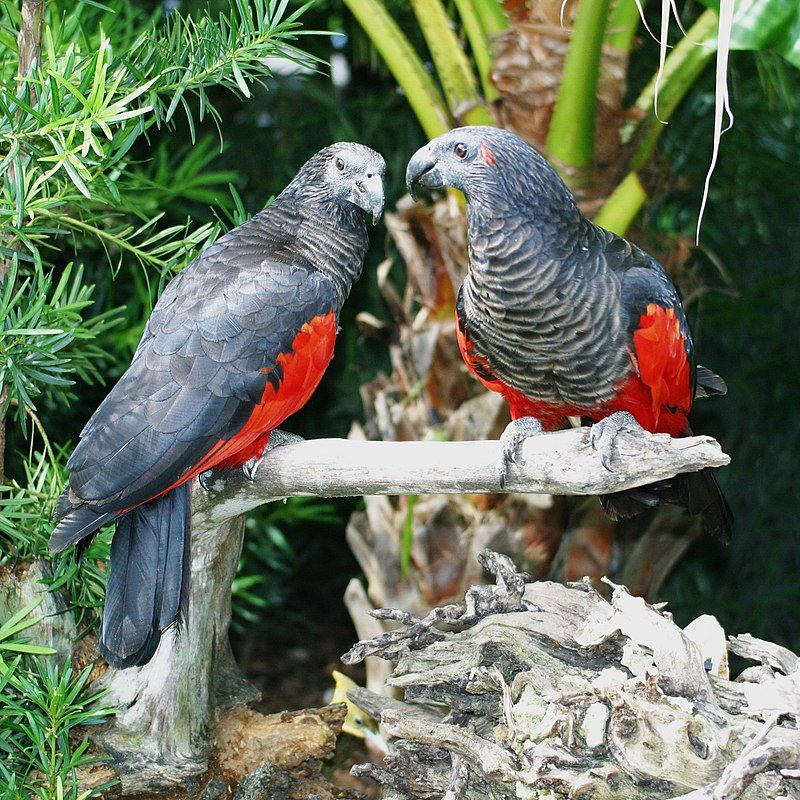
Pesquet’s parrot is an impressive bird from the Psittaculidae family, part of the larger group of Old World parrots.
Due to its striking appearance, it is the only species in the Psittrichas genus and is sometimes referred to as the Dracula parrot or the vulturine parrot.
This species is endemic to the rainforested hills and mountains of New Guinea, the world’s second-largest island, where it is found at altitudes of up to 1500 meters. It is mainly a frugivorous species but eats flowers, seeds, leaves, and insects.
It is considered a threatened species due to habitat destruction and poaching and is protected by the Government of Papua New Guinea.
| Kingdom | Animalia |
| Phylum | Chordata |
| Class | Aves |
| Order | Psittaciformes |
| Family | Psittaculidae |
| Genus | Psittrichas |
| Species | P. fulgidus |
3. Greater Ground Robin
The Greater Ground Robin (GGR) is a bird native to New Guinea. It is a part of the Petroicidae family, a group of passerine birds commonly known as “Australasian robins.” The GGR is a medium-sized bird with a length of 16-19 cm.
It is easily recognized by its distinct plumage, which features gray-brown upperparts and bright rufous underparts. Its wings are dusky-gray, with a white bar, and its tail is black with white tips.
The GGR is usually found in tropical lowland forests and coastal woodlands, but it has also been observed in secondary habitats, such as mangroves and coconut plantations. Its diet consists mainly of insects, but it also feeds on fruit, nectar, and other small animals.
The GGR is also known to be an active forager, using its long bill to probe in leaf litter for food. The GGR is not considered a threatened species but is vulnerable to deforestation and human disturbance.
| Kingdom | Animalia |
| Phylum | Chordata |
| Class | Aves |
| Order | Passeriformes |
| Family | Petroicidae |
| Genus | Amalocichla |
| Species | A. sclateriana |
4. Rusty Pitohui
The Rusty Pitohui is a species of bird belonging to the family Pachycephalidae. It is a small to medium-sized bird with a bright orange-red plumage and a black and white tail. It is found in the lowland forests and woodlands of the Aru Islands and New Guinea.
This species is unique, as it is the only known bird species in the world that is known to contain toxins in its feathers and skin, making it the only known “poisonous bird” in the world.
The toxins are derived from a diet of insects, which contain a neurotoxic alkaloid also found in some species of frogs. This toxin can cause skin irritation and numbness if touched, and it is thought to act as a defense mechanism for the bird against predators.
While the Rusty Pitohui is the only known poisonous bird, there are likely other species of birds with similar toxins in their feathers that have yet to be discovered.
| Kingdom | Animalia |
| Phylum | Chordata |
| Class | Aves |
| Order | Passeriformes |
| Family | Pachycephalidae |
| Genus | Pseudorectes |
| Species | P. ferrugineus |
5. Raggiana Bird-of-Paradise
The Raggiana bird-of-paradise is a beautiful and unique bird species found in the Paradisaeidae family. It is a large bird natively found in two parts of the world: southern and northeastern New Guinea. In New Guinea, the bird is referred to as ‘kumul’.
It is also known by the alternate name of ‘cenderawasih.’ This bird is quite popular among bird lovers due to its vibrant colors and unique shape.
The Raggiana bird-of-paradise symbolizes New Guinea and is essential to the country’s ecology and biodiversity. The bird is also a necessary part of the local culture, with stories and legends passed down through the generations.
The Raggiana bird-of-paradise is an important species to protect and conserve, as it is an integral part of the New Guinean culture and ecology.
| Kingdom | Animalia |
| Phylum | Chordata |
| Class | Aves |
| Order | Passeriformes |
| Family | Paradisaeidae |
| Genus | Paradisaea |
| Species | P. raggiana |
6. Southern Cassowary
The southern cassowary is a large black bird that is unable to fly. It is one of three species of cassowaries, the other two being the dwarf cassowary and the northern cassowary.
Names such as double-wattled cassowary, Australian cassowary, and two-wattled cassowary also refer to the southern cassowary. The southern cassowary can be found in the tropical forests of New Guinea and northeastern Australia.
It is a shy and solitary bird usually found alone, although pairs or small groups are known to exist.
It is an omnivore, and its diet consists primarily of fruits and other vegetation but also includes insects, small mammals, and small reptiles. The southern cassowary has a stout and robust body and is the world’s second tallest and second heaviest bird after the ostrich.
It has a bright blue or purple head and neck, and its body is covered in black feathers.
It also has a distinctive bony casque on its head and two large wattles hanging from either side of its beak. The southern cassowary is an essential species in the tropical rainforest ecosystem and plays a role in dispersing the seeds of many plant species.
It is also an essential part of the culture of many tribes that inhabit its range and is featured in many traditional stories and rituals.
Unfortunately, the southern cassowary is threatened by habitat loss and hunting and is listed as vulnerable on the IUCN Red List of Threatened Species.
| Kingdom | Animalia |
| Phylum | Chordata |
| Class | Aves |
| Order | Casuariiformes |
| Family | Casuariidae |
| Genus | Casuarius |
| Species | C. casuarius |
7. Victoria Crowned Pigeon
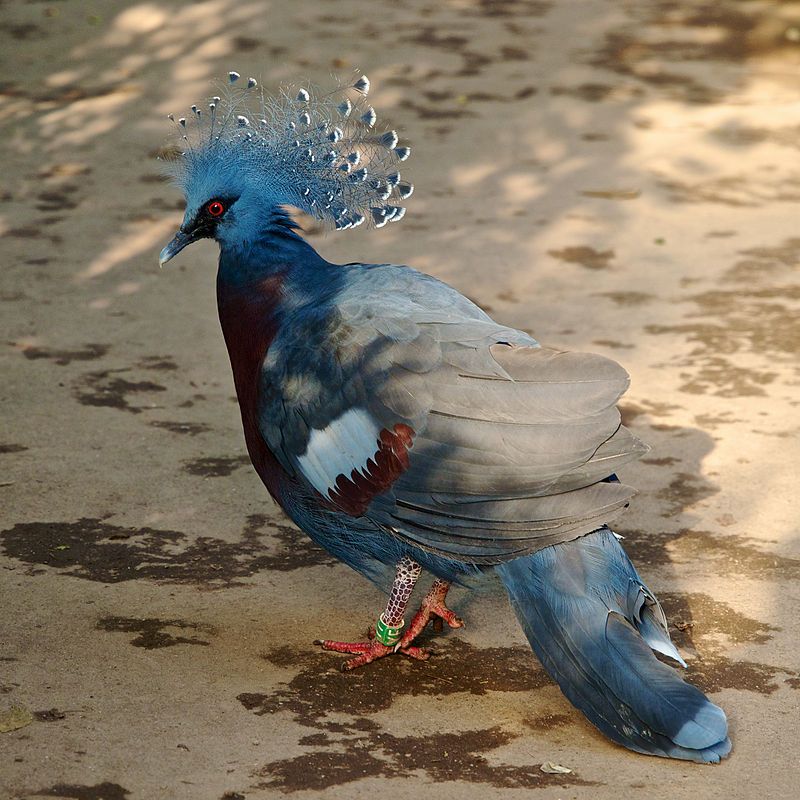
The Victoria-crowned pigeon is a majestic bird found in the New Guinea region. It has an impressive grayish-blue plumage and unique blue crests resembling lace. These crests are complemented by a vibrant maroon breast and red irises, making it a remarkable sight.
The Victoria crowned pigeon is part of a genus of large ground-dwelling pigeons of four species native to the New Guinea region. These birds have a unique habitat and lifestyle, preferring to live in dense lowland forests and remaining primarily terrestrial.
They feed on fruits, nuts, and invertebrates and have adapted their bodies to allow them to reach food sources from the ground.
The Victoria crowned pigeon is an incredible species, and its vibrant colors and unique behavior help to make it a highlight of the New Guinea region.
| Kingdom | Animalia |
| Phylum | Chordata |
| Class | Aves |
| Order | Columbiformes |
| Family | Columbidae |
| Genus | Goura |
| Species | G. victoria |
8. Ribbon-tailed Astrapia
The ribbon-tailed astrapia, also known as Shaw Mayer’s astrapia, is a bird-of-paradise species endemic to the subalpine forests in the western part of the central highlands of Papua New Guinea.
This species is unique in its appearance, with its long, ribbon-like tail feathers that are three times the length of its body. The male ribbon-tailed Australia is also particularly remarkable because of its polygamous tendencies.
Unlike other species of birds of paradise, the male ribbon-tailed Australia will mate with multiple females throughout its lifetime.
This species of bird of paradise is a sight to behold, and its appearance and mating behaviors have made it a popular subject for scientific research.
Its bright yellow plumage and long ribbon-like tail feathers make it a popular choice for bird watchers, as it is easily distinguishable from other species of birds of paradise.
Ribbon-tailed Australia is also a symbol of the unique biodiversity of the highlands of Papua New Guinea, and its conservation is essential for protecting its fragile habitat.
| Kingdom | Animalia |
| Phylum | Chordata |
| Class | Aves |
| Order | Passeriformes |
| Family | Paradisaeidae |
| Genus | Astrapia |
| Species | A. mayeri |
9. Blue Bird-of-paradise
The blue bird-of-paradise is a stunningly beautiful species of bird-of-paradise. It is a relatively large species with a wingspan of up to 22 inches. This species is unique because it is the only bird-of-paradise species in its genus, Paradisornis.
Before discovery and classification in its genus, the blue bird-of-paradise had been included in the genus Paradisaea, along with other bird-of-paradise species. This highlights the uniqueness of the species, as it is the only one of its kind in its genus.
The blue bird-of-paradise is a remarkable bird that stands out amongst other species in its family.
| Kingdom | Animalia |
| Phylum | Chordata |
| Class | Aves |
| Order | Passeriformes |
| Family | Paradisaeidae |
| Genus | Paradisornis |
| Species | P. rudolphi |
10. Lesser Bird-of-paradise
The lesser bird-of-paradise is a species of bird-of-paradise, a type of bird in the family Paradisaeidae. This species is found in the lowland and hill forests of New Guinea and the Aru Islands.
Its unique plumage and behavior characterize it, and it is one of the most spectacular birds in the world. The male has an iridescent blue-green head and a yellow-green throat. The mantle is black, and the tail is long and pointed.
The female is a plain brown bird with a yellowish-white throat. Both sexes also have long, curved beaks and blue feet. The lesser bird-of-paradise is solitary, usually seen alone or in pairs.
It forages for fruit, buds, and insects in the canopy of the rainforest. The lesser bird-of-paradise is classified as a species in the genus Paradisaea, the Latin name for the birds-of-paradise family.
The genus Paradisaea consists of twelve species, including the lesser bird-of-paradise. This species is listed as Near Threatened on the IUCN Red List due to its restricted range and the destruction of its habitat.
Conservation efforts are underway to protect this species and its habitat.
| Kingdom | Animalia |
| Phylum | Chordata |
| Class | Aves |
| Order | Passeriformes |
| Family | Paradisaeidae |
| Genus | Paradisaea |
| Species | P. minor |
11. Cassowaries
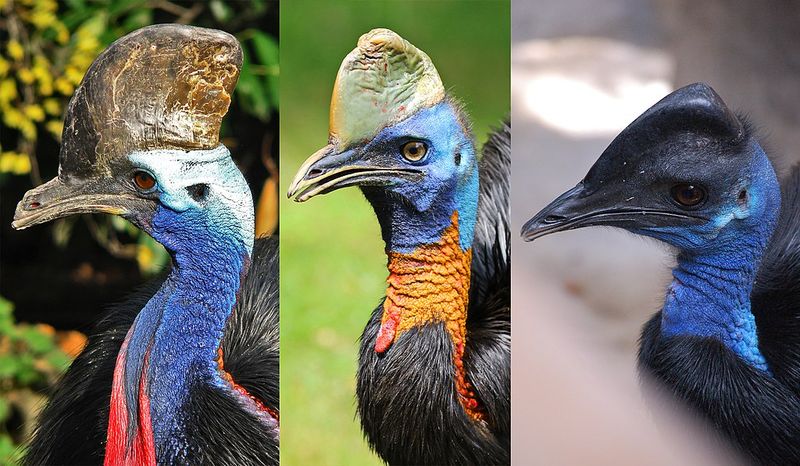
Cassowaries are a fascinating and unique group of birds. They are part of the genus Casuarius in the order Casuariiformes and are classified as ratites.
Ratites are a group of flightless birds that lack a keeled sternum, an anatomical feature that allows other birds to fly. These birds are native to the tropical forests of New Guinea, the Aru Islands, and northeastern Australia.
Three species of cassowaries are still alive today: the southern cassowary, the dwarf cassowary, and the northern cassowary. The southern cassowary is the largest species, reaching 6 feet tall.
It is a large, black bird with a bright red wattle on its neck. The dwarf cassowary, as its name suggests, is the smallest of the cassowary species, reaching up to 3 feet tall. It is a black bird with a red wattle and blue neck.
The northern cassowary is the middle species, reaching 4 feet tall. It is a black bird with a bright yellow neck and a red wattle. Cassowaries are omnivorous, meaning they eat both plants and animals.
They are mainly solitary animals but will gather in groups for protection or to mate. Cassowaries are important to their ecosystems because they help disperse seeds and regulate the population of insects, reptiles, and small mammals.
They also prey on larger predators, like big cats and birds of prey. Overall, cassowaries are an incredible group of birds that play an essential role in their environments. They are unique and fascinating creatures that deserve to be protected and appreciated.
| Kingdom | Animalia |
| Phylum | Chordata |
| Class | Aves |
| Order | Casuariiformes |
| Family | Casuariidae |
| Genus | Casuarius |
12. Greater Lophorina
The more extraordinary euphoria is a species in the Paradisaeidae family, commonly known as the superb bird-of-paradise or the greater superb bird-of-paradise. It is a unique species; until recently, it was the only species in the genus.
In 2017, however, scientists recognized three species within the genus. This discovery was significant, as it helped scientists better understand the species’ unique traits and behaviors.
Additionally, it allowed for a more accurate classification of the genus. By distinguishing between the three species, researchers could better understand their differences and how they evolved over time.
This new information can be used to inform conservation efforts, as well as to help identify and protect the species in the future.
| Kingdom | Animalia |
| Phylum | Chordata |
| Class | Aves |
| Order | Passeriformes |
| Family | Paradisaeidae |
| Genus | Lophorina |
| Species | L. superba |
13. Dwarf Cassowary
The dwarf cassowary is a species of large flightless bird native to the tropical rainforests of New Guinea. It is the smallest of the three species of cassowaries, also known as Bennett’s cassowary, little cassowary, mountain cassowary, or muruk.
The species is named for its size, about half the size of the other two species. The dwarf cassowary is a primarily solitary creature but occasionally forms small flocks. It is omnivorous, feeding various fruits, nuts, insects, and small animals.
It is rarely seen in the wild due to its shy nature and elusive habits. Unlike other species of cassowary, the dwarf cassowary doesn’t have a prominent crest. Its feathers are mostly black, with some white spots.
It also has a bright red neck and blue facial skin. The dwarf cassowary is considered a vulnerable species due to its small population size. It is hunted for its feathers and meat, as well as for its eggs. Its habitat is also being destroyed by deforestation.
Conservation efforts are underway to protect the species from further decline.
| Kingdom | Animalia |
| Phylum | Chordata |
| Class | Aves |
| Order | Casuariiformes |
| Family | Casuariidae |
| Genus | Casuarius |
| Species | C. bennetti |
14. Western Crowned Pigeon
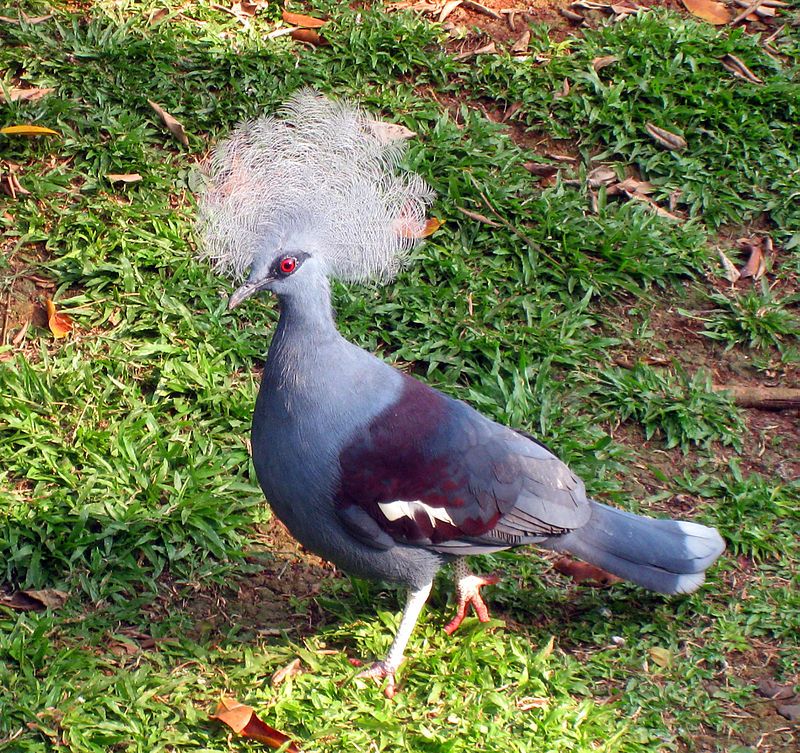
The western crowned pigeon, or the common crowned or blue crowned pigeon, is a large species easily recognizable due to its unique features.
It is a blue-grey bird with a blue lacy crest over its head and dark blue mask feathers around its eyes. Both sexes of this pigeon species are similar in appearance, though males are typically larger than females.
On average, the western crowned pigeon is about 70 cm long and weighs 2.1 kg. This species of pigeon is native to the lowland rainforests of New Guinea, where they are the largest pigeon species and are considered a symbol of peace and prosperity.
Their diet consists of fruits, seeds, and small insects, usually in pairs or small groups. The western crowned pigeon is considered a vulnerable species due to its slow reproductive rate and habitat destruction.
| Kingdom | Animalia |
| Phylum | Chordata |
| Class | Aves |
| Order | Columbiformes |
| Family | Columbidae |
| Genus | Goura |
| Species | G. cristata |
15. Scheepmaker’s Crowned Pigeon
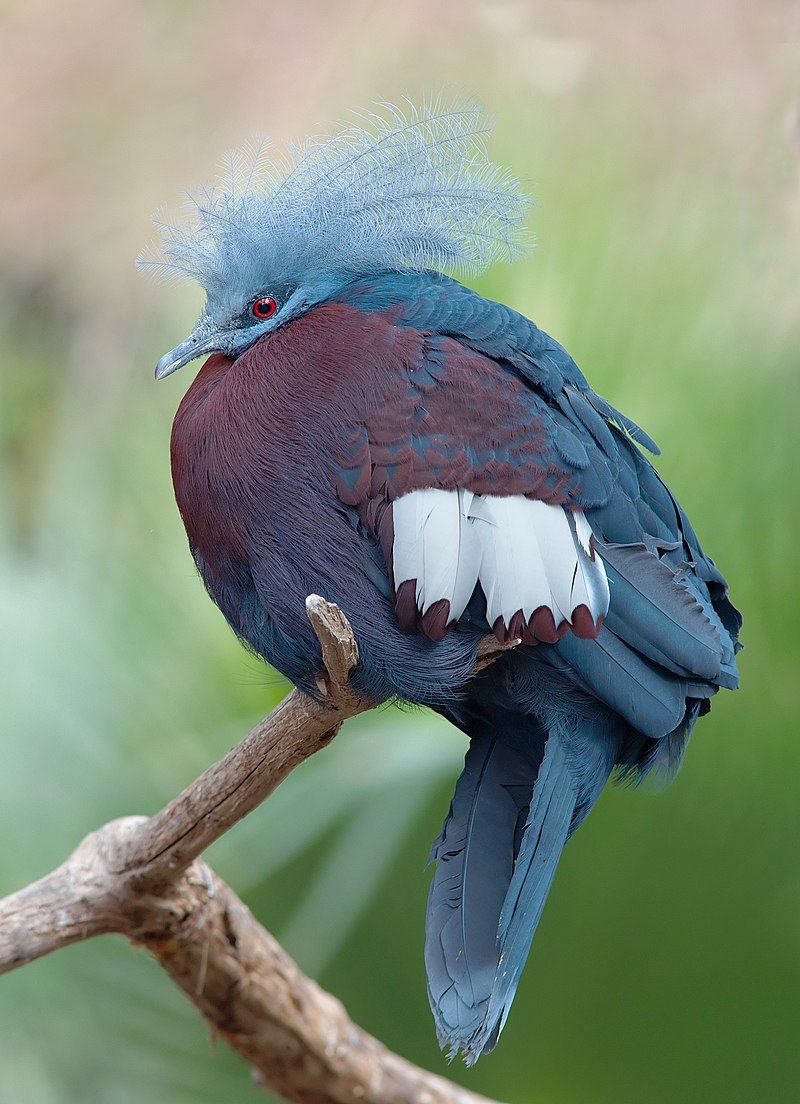
Scheepmaker’s crowned pigeon is an impressive and unique bird species found in southeastern New Guinea’s forests. This pigeon species is quite large and has mainly bluish-grey plumage with ornamental blue lace crests.
The most striking feature of this species is the intense maroon breast and the bright red iris of the eye. The male and the female have similar physical characteristics and coloration, so it can be difficult to tell them apart.
This pigeon species is a terrestrial bird, meaning it spends most of the day on the ground in the forest, although it can occasionally be seen in the trees. It usually feeds on the ground, eating seeds, insects, and other small creatures.
It also has a loud and distinctive call that helps to distinguish it from other species of birds. The crowned pigeon is an important species of bird in New Guinea.
It plays an essential role in maintaining the balance of the forest ecosystem, and it is also a beautiful and fascinating species to observe. Unfortunately, this species is threatened by habitat destruction, illegal hunting, and capture by the pet trade.
Conservation efforts are needed to ensure that this species does not become extinct.
| Kingdom | Animalia |
| Phylum | Chordata |
| Class | Aves |
| Order | Columbiformes |
| Family | Columbidae |
| Genus | Goura |
| Species | G. scheepmakeri |
16. Emperor Bird-of-paradise
The emperor bird-of-paradise is a species endemic to Papua New Guinea, meaning it is found only in that region. It inhabits hill forests on the Huon Peninsula, an area of the country on the north coast.
This species primarily feeds on fruits, figs, and arthropods, including insects, spiders, and other invertebrates. The emperor bird-of-paradise is also known as the emperor of Germany’s bird-of-paradise, an exciting name referencing its origin.
This species has adapted to its environment to survive, with its dietary habits an example of its adaptation. Fruits and figs provide it with necessary nutrition, and the arthropods form an essential part of its diet as a source of protein.
The emperor bird-of-paradise is a species of bird of paradise that stands out due to its unique habitat and lifestyle. Adapting to its environment has allowed it to thrive in its native home of Papua New Guinea.
| Kingdom | Animalia |
| Phylum | Chordata |
| Class | Aves |
| Order | Passeriformes |
| Family | Paradisaeidae |
| Genus | Paradisaea |
| Species | P. guilielmi |
17. Black Sicklebill
The black sicklebill is a large, impressive member of the birds of paradise family, Paradisaeidae. Native to Central New Guinea and the Vogelkop region, it is found in montane forests at altitudes ranging from 1800 to 2150 m.
This species is distinguishable by its size, black plumage, and curved bill that is longer than its head. The black sicklebill can be found throughout much of Central New Guinea, from the lowland and foothill forests to the montane forests at higher altitudes.
The Vogelkop Peninsula, located at the northwestern tip of New Guinea, is also home to this species, which is found in the montane forests at altitudes of 1800 to 2150 m.
The species is likely present in other parts of New Guinea, but further research is needed to confirm this. The black sicklebill is a magnificent bird with a long curved bill, black plumage, and bright yellow patches on its wings.
Not only is it a striking species to look at, but it also plays a vital role in the local ecosystems, as it helps disperse the seeds of various plants throughout the forests. In conclusion, the black sicklebill is a large and impressive member of the Birds of Paradise family in Central New Guinea and the Vogelkop region.
It inhabits montane forests at altitudes from 1800 to 2150 m, and its striking plumage and curved bill make it stand out amongst other species.
Furthermore, this species plays a vital role in the ecosystem, helping disperse the seeds of various plants throughout the forests.
| Kingdom | Animalia |
| Phylum | Chordata |
| Class | Aves |
| Order | Passeriformes |
| Family | Paradisaeidae |
| Genus | Epimachus |
| Species | E. fastosus |
18. Goldie’s Bird-of-paradise
Goldie’s bird-of-paradise is a unique species found only in the forests of the D’Entrecasteaux Archipelago in eastern Papua New Guinea. It is found mainly on the Fergusson and Normanby Islands, where it lives in the hill forests of these islands.
This bird-of-paradise species is quite particular in its diet and mainly eats fruits. Goldie’s bird of paradise has adapted to its environment and uses the abundance of fruits around it to sustain itself.
Due to its vibrant colors and unique characteristics, it has become a beloved species among bird watchers and bird lovers alike.
| Kingdom | Animalia |
| Phylum | Chordata |
| Class | Aves |
| Order | Passeriformes |
| Family | Paradisaeidae |
| Genus | Paradisaea |
| Species | P. decora |
19. Northern Cassowary
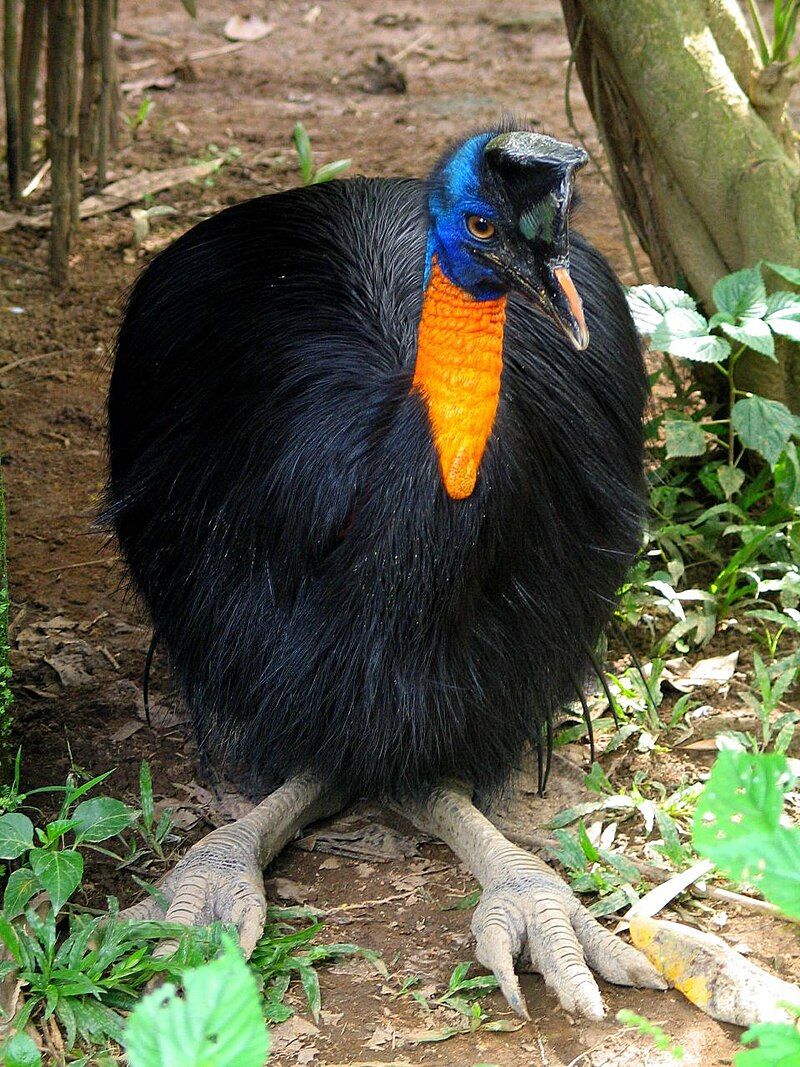
The northern cassowary is a large, stocky bird in New Guinea’s north. It is one of the three living species of cassowary, which includes the dwarf cassowary and the southern cassowary.
It is also known as the one-wattled cassowary, single-wattled cassowary, or golden-necked cassowary. As a flightless bird, the northern cassowary relies on its strong legs and sharp claws for protection and mobility.
Its strong legs and claws also help it forage for food in the dense rainforest and move around its environment.
The northern cassowary is a unique and fascinating creature, and its presence in the tropical environment of New Guinea helps to maintain the biodiversity of the region.
| Kingdom | Animalia |
| Phylum | Chordata |
| Class | Aves |
| Order | Casuariiformes |
| Family | Casuariidae |
| Genus | Casuarius |
| Species | C. unappendiculatus |
20. Hooded Pitohui
The hooded Pitohui is a species of bird found in New Guinea, belonging to the genus Pitohui. Initially, it was believed to be a part of the Whistler family, but further research revealed that it was more closely related to the Old World Oriole family.
This bird species is closely related to the variable pitohuis, which share the same genus, before being related to figbirds.
This relationship to the Old World oriole family is unique, as this bird species is the only known member of the Pitohui genus to be related to the family.
By understanding this relationship, scientists can gain further insights into the hooded Ppitohui’s evolutionary process and the species of birds found in the Old World oriole family.
| Kingdom | Animalia |
| Phylum | Chordata |
| Class | Aves |
| Order | Passeriformes |
| Family | Oriolidae |
| Genus | Pitohui |
| Species | P. dichrous |
Conclusion
Papua is an incredible place for bird watchers to explore. With its wide range of habitats, from tropical lowlands to alpine forests, Papua is home to an astonishing array of bird species, including some of the world’s most colorful and exotic birds.
With careful observation and dedication, bird watchers can observe some of the rarest species in the world up close. Papua is genuinely a birdwatcher’s paradise.